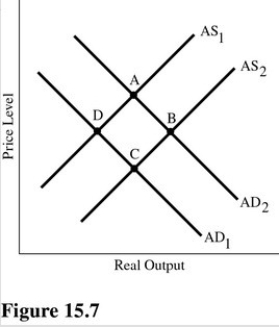A) Decrease as interest rates fall.
B) Increase as interest rates fall.
C) Increase as the money supply decreases.
D) Decrease when the speculative demand increases.
Correct Answer

verified
Correct Answer
verified
Multiple Choice
In which of the following situations is expansionary monetary policy most effective?
A) The Fed raises the reserve requirement.
B) The Fed raises the discount rate.
C) The Fed sells more securities.
D) Banks are willing to lend excess reserves.
Correct Answer

verified
Correct Answer
verified
Multiple Choice
Which of the following is less sensitive to interest rate changes?
A) The residential housing market.
B) Food and other household items.
C) Utility industries.
D) State and local finances.
Correct Answer

verified
Correct Answer
verified
Multiple Choice
If the real rate of interest is negative,then,ceteris paribus,
A) The nominal interest rate is negative.
B) Monetary policy is tight.
C) The nominal interest rate is less than the anticipated inflation rate.
D) The inflation rate is negative.
Correct Answer

verified
Correct Answer
verified
Multiple Choice
Assuming the aggregate supply curve is vertical,which of the following is most likely to occur if the Fed pursues expansionary monetary policy?
A) The equilibrium price level and output will both increase.
B) The equilibrium price level and output will both decrease.
C) The equilibrium price level will increase but output will stay the same.
D) The equilibrium output will increase but the price level will stay the same.
Correct Answer

verified
Correct Answer
verified
Multiple Choice
The normal market demand curve for money is
A) A horizontal curve at very high interest rates,where the quantity demanded changes but the interest rate is constant.
B) An upward-sloping demand curve,where more money is held when interest rates are higher.
C) A vertical demand curve,where the same amount of money is held regardless of the interest rate.
D) A downward-sloping demand curve,where more money is held at lower interest rates.
Correct Answer

verified
Correct Answer
verified
Multiple Choice
Using the equation of exchange and assuming full employment and a constant velocity of money,a decrease in the required reserve ratio would result in a
A) Lower velocity.
B) Lower quantity of real output.
C) Higher price level.
D) Lower price level.
Correct Answer

verified
Correct Answer
verified
Multiple Choice
Monetary stimulus will fail if
A) Banks are reluctant to lend money.
B) The investment demand curve is fairly flat.
C) The money demand curve is fairly steep.
D) Consumers begin to spend more.
Correct Answer

verified
Correct Answer
verified
Multiple Choice
An increase in the money supply will
A) Reduce interest rates and increase aggregate demand.
B) Reduce interest rates and decrease aggregate demand.
C) Raise interest rates and increase aggregate demand.
D) Raise interest rates and decrease aggregate demand.
Correct Answer

verified
Correct Answer
verified
Multiple Choice
When monetary policy reduces interest rates,
A) The income for retired people increases.
B) Income is redistributed from lenders to borrowers.
C) The construction industry is negatively impacted.
D) The money supply curve decreases.
Correct Answer

verified
Correct Answer
verified
Multiple Choice
Which of the following groups believes monetary policy to be effective for fighting inflation but not for changing real output?
A) Keynesian economists.
B) Classical economists.
C) Monetarists.
D) Neo-Keynesian economists.
Correct Answer

verified
Correct Answer
verified
Multiple Choice
According to Bernanke's policy guide,a 1/4 point decrease in long-term interest rates results in a
A) $10 billion stimulus for the economy.
B) $50 billion stimulus for the economy.
C) $10 billion decrease for the economy.
D) $50 billion decrease for the economy.
Correct Answer

verified
Correct Answer
verified
Multiple Choice
Keynes believed that monetary stimulus would be ineffective during a recession because of all of the following except
A) The liquidity trap.
B) Low expectations.
C) The reluctance of banks to lend.
D) The willingness of consumers to increase consumption when interest rates fall.
Correct Answer

verified
Correct Answer
verified
Multiple Choice
A monetary stimulus is designed to shift the
A) AS curve to the right.
B) AS curve to the left.
C) AD curve to the right.
D) AD curve to the left.
Correct Answer

verified
Correct Answer
verified
Multiple Choice
Money held for making everyday market purchases represents the
A) Crisis demand for money.
B) Speculative demand for money.
C) Transactions demand for money.
D) Precautionary demand for money.
Correct Answer

verified
Correct Answer
verified
True/False
The liquidity trap exists because the lower portion of the money demand curve is horizontal.
Correct Answer

verified
Correct Answer
verified
Multiple Choice
 Refer to Figure 15.7.Suppose the money supply decreases.This will cause interest rates to ________ and cause a shift from point ________.
Refer to Figure 15.7.Suppose the money supply decreases.This will cause interest rates to ________ and cause a shift from point ________.
A) increase;A to point B
B) decrease;B to point A
C) increase;A to point D
D) decrease;C to point D
Correct Answer

verified
Correct Answer
verified
Multiple Choice
Monetary stimulus may be ineffective if
A) The investment demand curve is inelastic.
B) Expectations of a boom cause the investment demand curve to shift to the right,offsetting interest rate effects that would stimulate the economy.
C) The investment demand curve is horizontal.
D) People usually respond to lower interest rates by consuming more goods and services.
Correct Answer

verified
Correct Answer
verified
Multiple Choice
The federal funds rate is the interest rate for
A) Reserves borrowed from the Fed.
B) Money lent to a bank's best business customers.
C) Reserves lent by banks to the Fed.
D) Interbank reserve loans.
Correct Answer

verified
Correct Answer
verified
Multiple Choice
The money supply curve as determined by current Federal Reserve policy is
A) Vertical since it's not determined by the interest rate.
B) Horizontal since it's not determined by the interest rate.
C) Upward-sloping to the right.
D) Downward-sloping to the right.
Correct Answer

verified
Correct Answer
verified
Showing 61 - 80 of 149
Related Exams